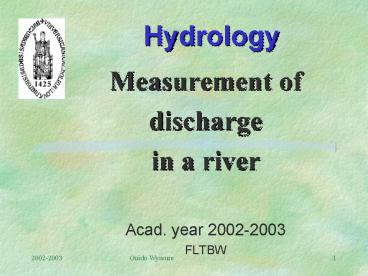Hydrology PowerPoint PPT Presentation
1 / 32
Title: Hydrology
1
Hydrology
- Measurement of
- discharge
- in a river
- Acad. year 2002-2003
- FLTBW
2
Discharge in a river
- Aim to determine the runoff of a river system
output of the hydrologic system - Often continuous measurement of water level which
is translated to a discharge - Some principles of open channel flow are useful
- Hydraulic structures are most useful if possible
- Examples
3
Usual practice
- Continuous measurement of water level (stage)
- Pressure transducer float ultrasonic etc
- Stage-discharge curve (debietdischarge)
- Occasional velocity-area measure velocity and
cross-section area (float method quick idea
current meter precise) - Occasional dilution method (tracer injection)
- Hydraulic structures (e.g. Parshall Flume
V-notch) well-known and precise relation
discharge-stage - New methods. Laser-doppler
4
Bernouilli energy equation
Energy -loss
Total potential
V2/2g
Open water surface
H1
D
H2
Rivier bottom
z
Reference heigth
5
Bernouilli energy equation
- Energy of the water on the bottom per unit of
weight discharge - Pressure D expressed in waterdepth (D P/?g)
- Height of bottom z
- Average velocity V in a cross-section
- Beware open canals (wet cross-section is not
constant like in a filled pipe) - Head losses hL friction and local
- In a vertical the potential remains constant
6
Reynolds number laminair of turbulent
- Water ?10-6 m²/s normall turbulent
- 4 Rh characteristic length (diameter pipe)
- Rh A/P hydraulic radius (!!!!!!!)
- Sheet flow over smooth surface could be laminair
(rather exceptional)
7
Uniform open chanal-flow
- Uniform (eenparig) constant cross-section
watersurface, bottom- and energy line are
parallel - gt friction loss in equilibrium
- Manning formula (turbulent)
Relation discharge- waterheight is uniform
Rahter rare in natural rivers
8
(No Transcript)
9
Rivier is not a simple channel
Uniform flow mostly in artificial canals (
irrigation) Backwater widening bends etc are
common in natural rivers
10
Usually non-uniform (of niet eenparige) flow
- Gradually varying ( little local loss mainly by
friction) - Theoretical calculations are possible
- Backwater curves slow widening etc.
- Rapidly varying (local loss important)
- Over short distance (e.g. Hydraulic jump)
- Relation water level and discharge in natural
rivers not necessarily uniform but more complex
11
Specific energy ( typical concept for open
channel flow)
- Specific energy ( energy relative to bottom)
- Open channels for a given discharge several
combinations of D and V are possible - For a given discharge there is a minimal specific
energy the critical depth or also the critical
flow
12
Critical flow
- Flow at a weir (overlaat)
- Waterfall
- Between mild and steep slope
- Critical flow
- Uniform relation between heigth and discharge at
critical flow
13
Froude number type of flow
- Open channel flow is
- Supercritical or shooting Frgt1
- Critical Fr 1
- Subcritical Frlt1
- Froude number expresses the proportion of kinetic
energy/ water depth in a dimensionless number. - Measurement at Fr gt0.5 is difficult (lots of
kinetic energy and a relatively low level)
14
Good control section
- Critical depth stabilizes the relation between
discharge and level - However low levels high kinetic energygt very
difficult for accurate and sensitive measurements - Downstream of critical flow
- good control with good relation discharge and
level and easy to measure large levels with low
kinetic energy - (Fr lt0.5 lower kinetic energy)
15
Hydraulic structures
- Welldefined structures with well-known transition
from critical to subcritical - Uniform and constant discharge level relation
- Fr lt 0.5 (sufficient level and lower kinetic
energy) and so high sensitivity to level - Avoid sedimentation ( at lower Fr)
- If possible with a minimum of energy-loss
16
Example of a structure Parshall flume
- Standardized design exact and different sizes
- Very good throughflow low sedimentation and low
energy loss - Expensive and rather complicated construction
- Not so flexible to fitt in a river or channel
- Design and construction errors common by not
following the guidelines precisely!!!
17
Parshall flume
18
Parshall UCL
Common in Watertreatment plants
19
Scharpcrested weir (scherpe overlaten V-notch
e.g.)
- Simple and cheap ()
- Easy to fit ()
- Large energy loss (- -)
- Fast sedimentation (with clean water no problem)
(-) - Can be very accurate if well constructed (/-)
20
V-notch weir
H
21
V-notch UCL
22
V-notch Greece-drinking water
23
V-notch Tanzania sedimented (-)
Level-Recorder
24
RBC-flumes
- Good compromise flexible construction sediment
passes well and little energy loss - Can be fitted in most cross-sections (pipe,
trapezoidal etc)
Critical flow
measurement
25
RBC in irrigation channel
26
Ad hoc structures
- Require calibration Cw by experiments
- Powerfunctions with sometime a known power
- Rectangular weir B 1.5 and W width
- Triangular weir B 2.5 (and W 1)
27
V-notch rectangular for high flows
28
Adhoc structures e.g. watermill
Voer Bertem (41 km²)
Voer Heverlee (51 km²)
29
Volumetric Flow rate Measurements
- liters per minute
- cubic meters per second (m3/sec) or
- liters per second (l/s).
30
Velocity-Area Flow Rate Measurements in rivers
- Q A V
- where
- Q - flow rate, volume per unit time
- A - cross-sectional area of flow
- V - mean velocity of flow
31
Current meter velocity
32
Velocity area

